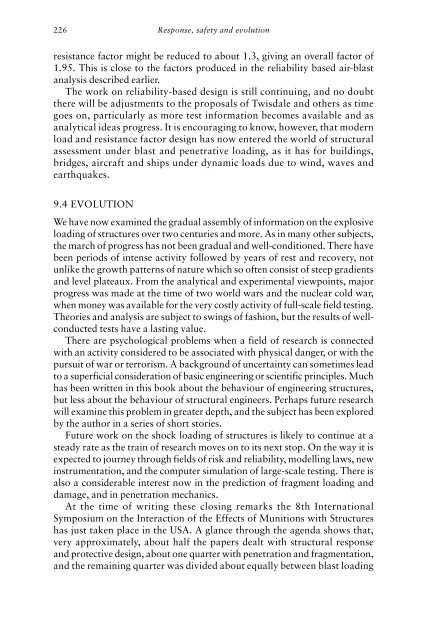A History of Research and a Review of Recent Developments
A History of Research and a Review of Recent Developments
A History of Research and a Review of Recent Developments
You also want an ePaper? Increase the reach of your titles
YUMPU automatically turns print PDFs into web optimized ePapers that Google loves.
226<br />
Response, safety <strong>and</strong> evolution<br />
resistance factor might be reduced to about 1.3, giving an overall factor <strong>of</strong><br />
1.95. This is close to the factors produced in the reliability based air-blast<br />
analysis described earlier.<br />
The work on reliability-based design is still continuing, <strong>and</strong> no doubt<br />
there will be adjustments to the proposals <strong>of</strong> Twisdale <strong>and</strong> others as time<br />
goes on, particularly as more test information becomes available <strong>and</strong> as<br />
analytical ideas progress. It is encouraging to know, however, that modern<br />
load <strong>and</strong> resistance factor design has now entered the world <strong>of</strong> structural<br />
assessment under blast <strong>and</strong> penetrative loading, as it has for buildings,<br />
bridges, aircraft <strong>and</strong> ships under dynamic loads due to wind, waves <strong>and</strong><br />
earthquakes.<br />
9.4 EVOLUTION<br />
We have now examined the gradual assembly <strong>of</strong> information on the explosive<br />
loading <strong>of</strong> structures over two centuries <strong>and</strong> more. As in many other subjects,<br />
the march <strong>of</strong> progress has not been gradual <strong>and</strong> well-conditioned. There have<br />
been periods <strong>of</strong> intense activity followed by years <strong>of</strong> rest <strong>and</strong> recovery, not<br />
unlike the growth patterns <strong>of</strong> nature which so <strong>of</strong>ten consist <strong>of</strong> steep gradients<br />
<strong>and</strong> level plateaux. From the analytical <strong>and</strong> experimental viewpoints, major<br />
progress was made at the time <strong>of</strong> two world wars <strong>and</strong> the nuclear cold war,<br />
when money was available for the very costly activity <strong>of</strong> full-scale field testing.<br />
Theories <strong>and</strong> analysis are subject to swings <strong>of</strong> fashion, but the results <strong>of</strong> wellconducted<br />
tests have a lasting value.<br />
There are psychological problems when a field <strong>of</strong> research is connected<br />
with an activity considered to be associated with physical danger, or with the<br />
pursuit <strong>of</strong> war or terrorism. A background <strong>of</strong> uncertainty can sometimes lead<br />
to a superficial consideration <strong>of</strong> basic engineering or scientific principles. Much<br />
has been written in this book about the behaviour <strong>of</strong> engineering structures,<br />
but less about the behaviour <strong>of</strong> structural engineers. Perhaps future research<br />
will examine this problem in greater depth, <strong>and</strong> the subject has been explored<br />
by the author in a series <strong>of</strong> short stories.<br />
Future work on the shock loading <strong>of</strong> structures is likely to continue at a<br />
steady rate as the train <strong>of</strong> research moves on to its next stop. On the way it is<br />
expected to journey through fields <strong>of</strong> risk <strong>and</strong> reliability, modelling laws, new<br />
instrumentation, <strong>and</strong> the computer simulation <strong>of</strong> large-scale testing. There is<br />
also a considerable interest now in the prediction <strong>of</strong> fragment loading <strong>and</strong><br />
damage, <strong>and</strong> in penetration mechanics.<br />
At the time <strong>of</strong> writing these closing remarks the 8th International<br />
Symposium on the Interaction <strong>of</strong> the Effects <strong>of</strong> Munitions with Structures<br />
has just taken place in the USA. A glance through the agenda shows that,<br />
very approximately, about half the papers dealt with structural response<br />
<strong>and</strong> protective design, about one quarter with penetration <strong>and</strong> fragmentation,<br />
<strong>and</strong> the remaining quarter was divided about equally between blast loading


